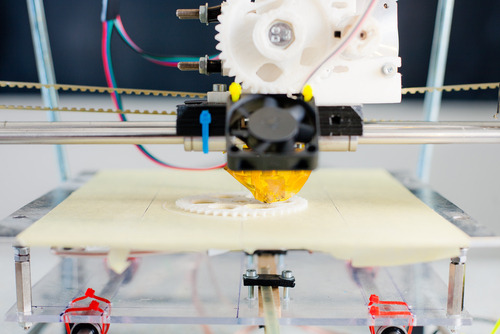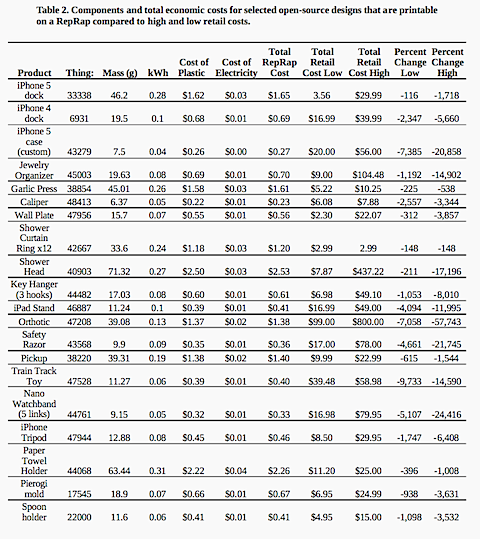
Study Finds Major Savings Through Household 3-D Printing
Though 3-D printing may still be a long way from the Star Trek
replicator that can create any object on demand, a new study has found
that a currently available machine could save the average household
considerable money.
Michigan Technological University engineers conducted an economic analysis of 3-D printing simple goods like toys, kitchen aids and tools at home using a low-cost open-source device like one called a RepRap. The manufacturing technique called 3-D printing builds objects through a computer-guided extrusion head that deposits successive layers of plastic or other material.
“RepRaps have been proposed and demonstrated to be useful for conventional prototyping and engineering, customizing scientific equipment, and appropriate technology-related manufacturing for sustainable development,” the study’s authors write. “However, in order for this technology to proliferate like 2-D electronic printers have, it must be economically viable for a typical household.”
The RepRap—short for replicating rapid prototyper—has become a pillar of the maker community for several reasons, including that it can build many of the parts needed to make an exact copy of itself.
The team used a life-cycle analysis to compare whether buying consumer products online or printing them out with a RepRap would ultimately be more economical for the average U.S. household.
They chose 20 common items—including a garlic press, a showerhead and an iPhone case—that they could purchase online and which also had free digital files available that could guide their printer to make the goods. They found the minimum and maximum prices it cost to buy the items online through Google Shopping and compared that against material and electricity costs for running the printer.
What they found was a stark contrast between buying complete goods and making them at home: It would cost a consumer from $312 to $1,944 to purchase the 20 items online compared to $18 to print them over the course of a weekend.

(A table showing cost differences from the article “Life-Cycle Economic Analysis of Distributed Manufacturing with Open-Source 3D Printers," to be published in the journal Mechatronics. Courtesy Joshua Pearce/MTU.)
Engineering professor and study coauthor Joshua Pearce said in a statement that the machines aren’t yet as simple to set-up or operate as they soon will be. Still, they’re not so complicated that users need a degree to start making key hangers and paper towel holders. “You don’t need to be an engineer or a professional technician to set up a 3-D printer,” he says. “Some can be set up in under half an hour, and even the RepRap can be built in a weekend by a reasonably handy do-it-yourselfer.”
Since the price tag of an open-source 3-D printer can range from $350 to $2,000, the researchers calculated the cost savings of making 20 similar items a year would allow a household to pay off the device in a few months to a few years.
“For the average American consumer, 3-D printing is ready for show time,” Pearce said. “With the exponential growth of free designs and expansion of 3-D printing, we are creating enormous potential wealth for everyone.”
Top Image: A 3-D printer at work, via Shutterstock.
Michigan Technological University engineers conducted an economic analysis of 3-D printing simple goods like toys, kitchen aids and tools at home using a low-cost open-source device like one called a RepRap. The manufacturing technique called 3-D printing builds objects through a computer-guided extrusion head that deposits successive layers of plastic or other material.
“RepRaps have been proposed and demonstrated to be useful for conventional prototyping and engineering, customizing scientific equipment, and appropriate technology-related manufacturing for sustainable development,” the study’s authors write. “However, in order for this technology to proliferate like 2-D electronic printers have, it must be economically viable for a typical household.”
The RepRap—short for replicating rapid prototyper—has become a pillar of the maker community for several reasons, including that it can build many of the parts needed to make an exact copy of itself.
The team used a life-cycle analysis to compare whether buying consumer products online or printing them out with a RepRap would ultimately be more economical for the average U.S. household.
They chose 20 common items—including a garlic press, a showerhead and an iPhone case—that they could purchase online and which also had free digital files available that could guide their printer to make the goods. They found the minimum and maximum prices it cost to buy the items online through Google Shopping and compared that against material and electricity costs for running the printer.
What they found was a stark contrast between buying complete goods and making them at home: It would cost a consumer from $312 to $1,944 to purchase the 20 items online compared to $18 to print them over the course of a weekend.

(A table showing cost differences from the article “Life-Cycle Economic Analysis of Distributed Manufacturing with Open-Source 3D Printers," to be published in the journal Mechatronics. Courtesy Joshua Pearce/MTU.)
Engineering professor and study coauthor Joshua Pearce said in a statement that the machines aren’t yet as simple to set-up or operate as they soon will be. Still, they’re not so complicated that users need a degree to start making key hangers and paper towel holders. “You don’t need to be an engineer or a professional technician to set up a 3-D printer,” he says. “Some can be set up in under half an hour, and even the RepRap can be built in a weekend by a reasonably handy do-it-yourselfer.”
Since the price tag of an open-source 3-D printer can range from $350 to $2,000, the researchers calculated the cost savings of making 20 similar items a year would allow a household to pay off the device in a few months to a few years.
“For the average American consumer, 3-D printing is ready for show time,” Pearce said. “With the exponential growth of free designs and expansion of 3-D printing, we are creating enormous potential wealth for everyone.”
Top Image: A 3-D printer at work, via Shutterstock.
No comments:
Post a Comment